Home of majestic, rolling prairies and the Black Hills National forest, the ‘Mount Rushmore State’ of South Dakota is a great place to be a birder. A number of happy Avian species make their home here and they will be the topic of our article today. We’ll tell you about some of the birds that you can see and seek out in this state, as well as what they like to eat, where they like to hide, and we’ll even throw in a few feeder tips as well.
Let’s discuss the popular backyard birds of South Dakota!
3 Categories – 438 Birds
As you would expect from such beautiful natural surroundings, South Dakota is home to a number of happy birds who live here part time or even all years. With 438 identified species, we certainly don’t have the space to chronicle all the birds that you can find, but we CAN give you a sampling and divide them up seasonally like this:
- Year-round Resident birds
- Birds of Spring, Summer, and Early Fall
- Fall and Winter Birds
We’ll tell you how to identify the birds that you are likely to spot as well as what kind of feeder foods you can put out to tempt them to visit you. After that, we’ll even explore some hotspots around the state where you can go to see these birds in the most picturesque settings around South Dakota. Let’s start things off with the year-round resident birds.
South Dakota’s Year-round Resident birds
The year-round resident category birds may be found at any time of the year in a number of locations. We’ve selected a handful that you are quite likely to see if you keep an eye out. Try and spot one of the following year-round birds the next time you are out on errands and see how many that you can identify:
- Black-capped Chickadee
- Mourning Dove
- American Goldfinch
- Red-bellied Woodpecker
- White-breasted Nuthatch
Black-capped Chickadee – Poecile atricapillus
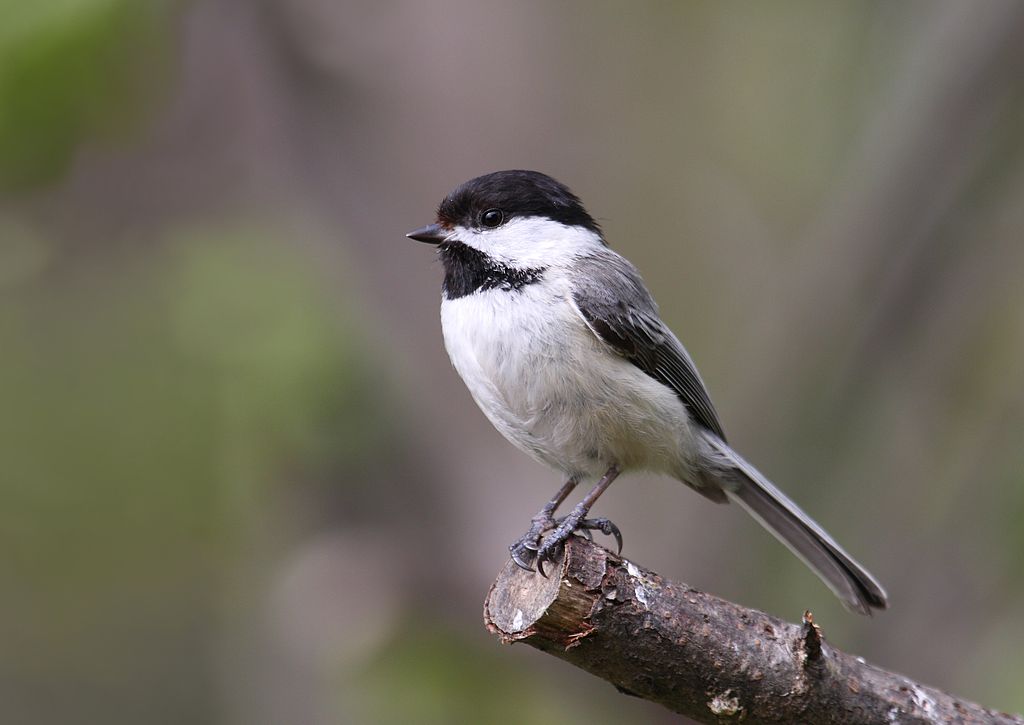
Coloration and Markings: Black-capped Chickadees have soft gray backs with short, gray wings that have some white edging and long, thin tails which are white on the outside edges as well. The underbelly and breast of this bird are white, with a light, buffy coloration at the flanks. Facially, these birds are black and white, with white in the center of the face and a small, black bib, along with a large, black cap that terminates at mid-eye level. These birds have small, triangular black bills.
Size: These diminutive birds measure in at 4.7 – 5.9 inches in length and have wingspans of 6.3 to 8.3 inches wide.
Habitat: While exceptionally fond of Alder and Birch trees, Black-capped Chickadees may be found in just about any combination of trees and shrub cover. Look for them at the forest’s edge, parks, woodlots, and backyards. They are also quite fond of water and like to perch on cattails, so look for them in marshes or around streams as well.
Diet: Suet and peanut butter mixed together is a favorite of these birds. They also like fruit, especially small berries, which you can leave out whole either in a fresh (preferred) or dry state.
Mourning Dove – Zenaida macroura
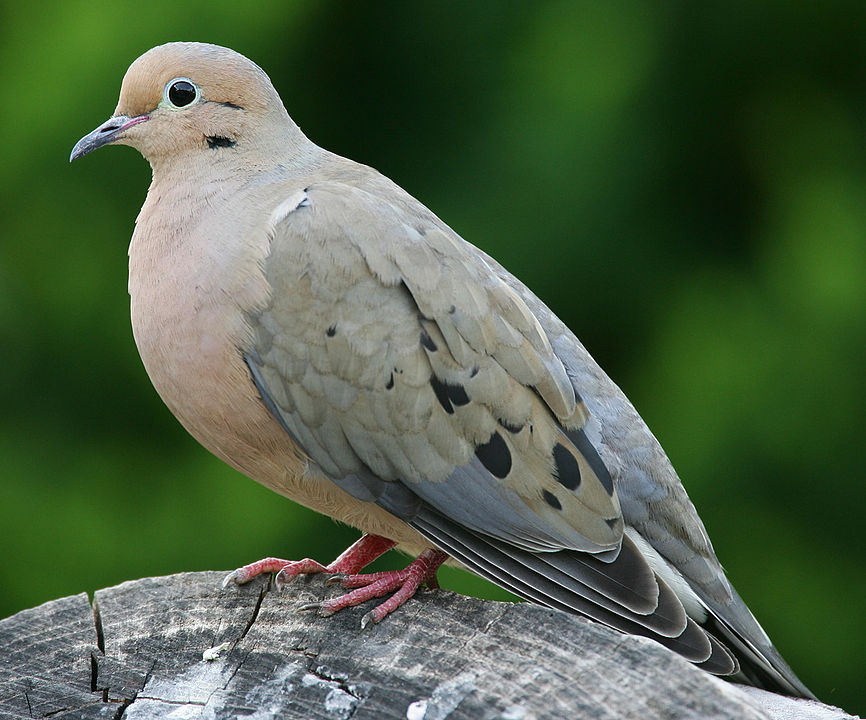
Coloration and Markings: Mourning Doves have gray or light brown backs, with broad and large wings and long, pointed tails. Their wings will contain a high concentration of buffy tan color as well as some distinctive black spots and the underbelly and breast of this bird will be a mix of white and creamy tan. Facially, these birds have the heaviest concentration of tan color and you will notice a thin, white eyering as well. These birds have thin, medium-length black bills.
Size: These birds measure in at 9.1 – 13.4 inches in length and have wingspans of approximately 17.7 inches wide.
Habitat: Mourning Doves don’t like the deep woods, preferring to spend their time in parks, farms, or more often, simply in the city. Look for them on fences, sidewalks, or telephone wires and you’ll be surprised how quickly you can spot the Mourning Dove.
Diet: Cracked corn, White Proso millet, and Nyjer thistle are 3 favorites that you can put out in your feeder if you would like to get the attentions of the Mourning Dove.
American Goldfinch – Spinus tristis

Coloration and Markings: Male American Goldfinches are quite colorful in the warm months, with bright yellow backs, long, black wings and medium-length black tails. The wings will display 2 white wingbars as well as a number of vertical white markings towards the lower center of the wings and tail. The underside of the tail is white with the coloration coming from the bird’s rump and the underbelly and breast will be the same bright yellow as the back. Facially, these birds are bright yellow with a black half-cap at the forehead and stout, medium-length orange bills. Females will have olive coloration instead of the black and the remaining yellow plumage will be duller in color than what is displayed on the male. In the winter, both genders adopt brown plumage but the wings will be noticeably darker and their wingbars are dim, but still present.
Size: These birds measure in at 4.3 – 5.1 inches in length and have wingspans of 7.1 to 8.7 inches wide.
Habitat: Goldfinches like to forage in weedy, overgrown fields, especially in areas prone to flooding. You can also find them in orchards, parks, and backyards so be sure to leave a little something out and you might just get a visit!
Diet: Stocking your feeder with Nyjer thistle is a simple and great way to attract the American Goldfinch into your backyard for a closer look.
Red-bellied Woodpecker – Melanerpes carolinus

Coloration and Markings: Red-bellied Woodpeckers are good looking birds, with zebra-like stripes on their backs, their long wings, and their short, notched tails. The underbelly and breast of this bird are white, however, a red spot is present at the belly and red wash is present at the breast and at the cheeks of this bird. The remainder of the face is mostly white, with the exception of the bird’s red cap which carries down to the nape of its neck. These birds have long, stout, and straight black bills.
Size: These birds measure in at approximately 9.4 inches from tip to tail and have wingspans of 13 to 16.5 inches in width.
Habitat: These birds love hardwoods and are especially found in stands of oak and hickory when you spot them in the woods. They are bold, like most Woodpeckers, so range often, found commonly in backyards with well-stocked feeders
Diet: Red-bellied Woodpeckers love suet, peanuts, and just about any fruits that you have on hand. They have a big sweet tooth, so don’t be too surprised if they wash it all down with a sip from your Hummingbird feeder as well.
White-breasted Nuthatch – Sitta carolinensis

Coloration and Markings: White-breasted Nuthatches have soft, grayish-blue backs with medium-length wings and tails of the same color. Both the wings and tail will display some black edging the thin traces of wingbars may sometimes be seen. The underbelly and breast of this bird are snowy white, with the exception of a rufous mark at the underbelly, and facially these birds are white with a black cap that goes down to the nape of the neck and extends slightly on the shoulders. A small, angular line is present come from out of the back of the eyes which give this bird a ‘slightly cross’ look and these birds have long, straight, bicolor bills which are black on top and gray to grayish black below.
Size: These birds measure in at 5.1 – 5.5 inches from tip to tail and have wingspans of 7.9 to 10.6 inches wide.
Habitat: Nuthatches may be found in the deep woods or at the forest’s edge, with a heavy preference for deciduous woods. That said, you can spot them sometimes in coniferous woods as well with less frequency.
Diet: While they mostly eat insects, White-breasted Nuthatches may be lured to your feeder with foods such as suet, live or dried mealworms, Black Oil Sunflower seeds, and crushed peanuts or peanut butter.
South Dakota’s Birds of Spring, Summer, and Early Fall
Rivers start melting, tulips begin peeking out of the ground, and American Robins start replacing the geese around formerly frozen lakes… it’s official, spring has arrived! During the warmer months there are a number of birds that will be making an appearance. See if you can spot one of these during spring, summer, or fall:
- Indigo Bunting
- Scarlet Tanager
- Blue Grosbeak
- Dickcissel
- Lazuli Bunting
Indigo Bunting – Passerina cyanea

Coloration and Markings: Male Indigo Buntings are quite the site, being almost completely indigo blue throughout their plumage. They have short wings and short tails, which sometimes display a little gray edging, and facially you can see the small beginnings of a crest as well as some black in front of each eye. These birds have stout, medium-length, and conical silver bills. Females look quite different, as they will be mostly an olive brown with olive and white streaked throat, breast, and underbelly and minor touches of blue present on their wings and tails. Juvenile males will be a mix of browns and blues, with the browns lessening as the bird grows into maturity.
Size: These birds measure in at 4.7 – 5.1 inches in length and have wingspans of 7.5 to 8.7 inches wide.
Habitat: These Buntings love bushes, brambles, thickets, and thorns. If you don’t hear them singing in the trees above you, then look towards the shrub cover, as this is where they like to forage.
Diet: Nyjer thistle, live mealworms, and small berries of just about any kind are the best way to attract the attentions of the Indigo Bunting.
Scarlet Tanager – Piranga olivacea
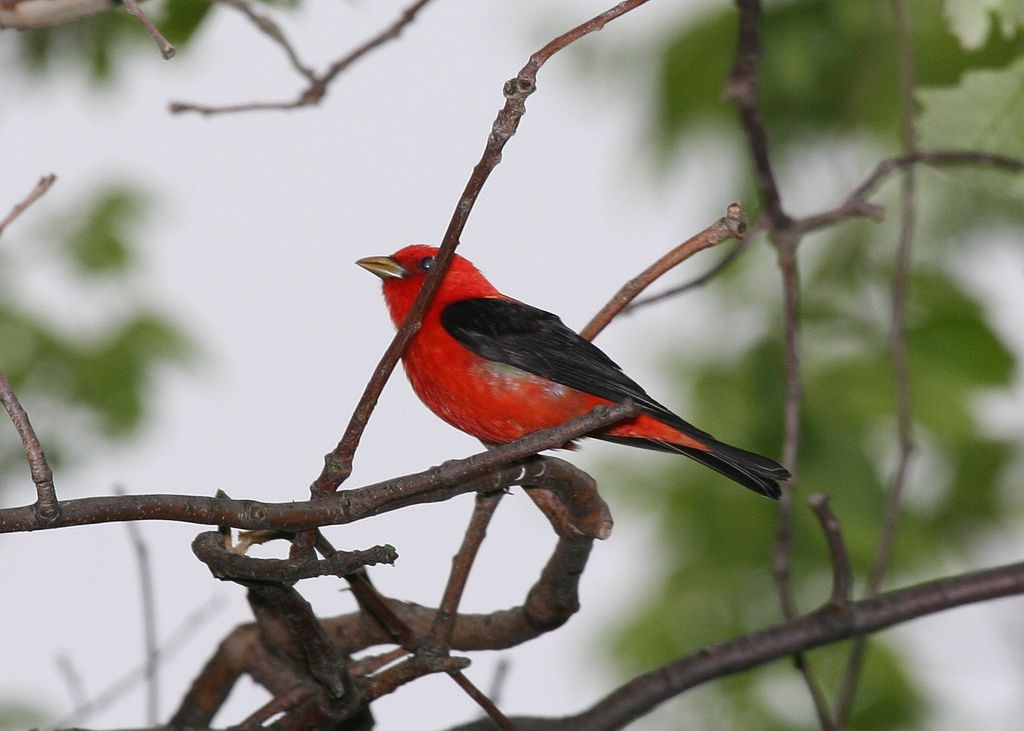
Coloration and Markings: During the warmer months, the male Scarlet Tanager has some very striking plumage. This bird has a red back with small black wings and a small, notched tail with extended outer tail feathers. Traces of yellow may sometimes be seen in the wings and the underbelly and breast of this bird will be red and often display a mix of yellow for a flame-color effect. Facially, these birds are red, with stout, medium length bills with a very slight curvature present. Females and juveniles will be more of an olive yellow, with darker olive wings, and outside of mating season adult males will look similar to the females and juveniles, with the exception of their black wings and tails.
Size: These birds measure in at 6.3 – 6.7 inches in length and have wingspans of 9.8 to 11.4 inches wide.
Habitat: During the warmer months, Tanagers prefer deciduous or deciduous evergreen mixed woodlands, tending to range more during migration periods. During this time you can often spot them in parks and backyards.
Diet: Suet, mealworms, orange-halves, and grape jelly are all favorites of the Scarlet Tanager. Leave one or more of these in your feeder and you might just make a new friend.
Blue Grosbeak – Passerina caerulea
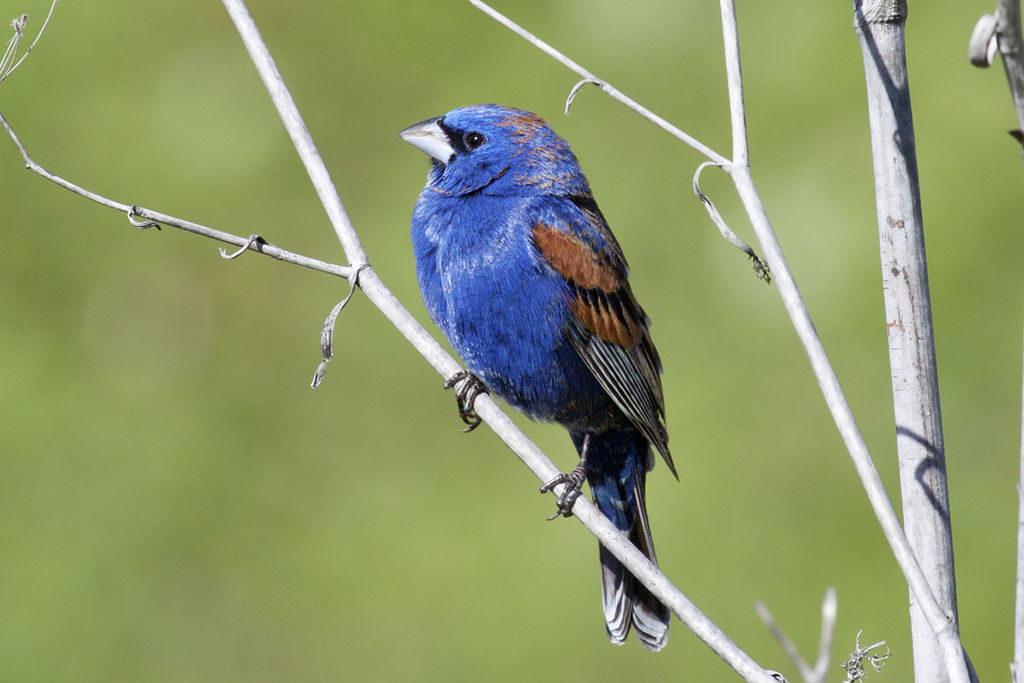
Coloration and Markings: Male Blue Grosbeaks have very striking plumage as adults. They have deep, blue backs with medium-length blue wings and tails. Their wings will have1 chestnut to cinnamon wingbar and another which is cinnamon and gray, as well as light or heavy edging in the feathers of the same color. The underbelly and breast of this bird are deep blue and facially, these birds are deep blue with a black half-mask in front and just under the eyes. These bird have large, triangular, down-ward curved gray bills. Female Grosbeaks will be mostly cinnamon in color with light coloration at the underbelly and breast. Juveniles will be almost completely chestnut brown with both wingbars matching.
Size: These birds measure 5.9 – 6.3 inches from head to tail and have wingspans averaging 11 inches wide.
Habitat: Old, overgrown fields, especially with a handful of large trees are a favorite environment of Grosbeaks. They like areas which are going to wild, especially if there is a lot of shrub cover present.
Diet: While they eat a lot of insects in the wild, you can lure Blue Grosbeaks with treats like peanuts, cherries, and suet nuggets with a good chance of getting their attentions once they know where to find your feeder.
Dickcissel – Spiza americana

Coloration and Markings: Dickcissels have brown and gray backs with long, broad gray wings with brown shoulders and the thin traces of a brown wingbar as well as a short, gray tails. The underbelly and breast of this bird are white with grays present in the plumage as well as a large, yellow v-shape of coloration on the chest and a black v present above the throat. Facially, these birds are mostly gray, with an eyestripe which is yellow in front and white behind the eyes as well as a yellow spot present at the lower bill and a thin, gray mustache line. These birds have medium-length, conical, and brown or gray bills. Female coloration will be similar, with the exception of a lack of the black v mark which you see on the males, and juveniles will lack gray and yellow, being instead mostly brown except for their distinctive eyelines and mustache lines.
Size: These birds measure in at 5.5 – 6.3 inches in length and have wingspans of 9.8 to 10.2 inches wide.
Habitat: These birds love high grasses, prairies, and pastures but they occasionally range out, to be found at roadsides and the occasional backyard.
Diet: While primarily insectivorous, during the winter these birds switch to a diet of seeds. At this time they might just pay your feeder a visit if you leave out small seeds and treats like Nyjer thistle, broken up Sunflower seeds, wheat, and rolled oats.
Lazuli Bunting – Passerina amoena

Coloration and Markings: Adult male Lazuli Buntings have lovely blue backs with medium-length blue wings which have black highlights, a white shoulder patch, and a white wingbar. They have medium length blue tails which have a little black and white underneath. The rump, underbelly, and breast of this bird are white with a heavy flanking of cinnamon coloration which widens to fill the chest. Facially, these birds are a light, indigo blue with a small amount of black in front of the eyes and stout, medium-length, and slightly curved black bills. Female Lazulis tend to have buffy tan wingbars and their upper bodies are grayish brown, with the occasional splashes of blue on the wings and the tail. Juveniles and non-breeding males will have pumpkin colored breasts and their faces and backs with be a mottled mix of blue and buffy tan color.
Size: These birds measure in at 5.1 – 5.9 inches in length and have wingspans of approximately 8.7 inches wide.
Habitat: The Buntings love valleys and hillsides, where the brush and the hedges are thick. You can also spot them near streams and in fields and they occasionally like to visit a backyard with a healthy garden and/or a well-stocked feeder.
Diet: White Proso millet and small berries, such as chopped cherries or whole blueberries, can sometimes get and keep the attentions of the lovely Lazuli Bunting.
South Dakota’s Fall and Winter Birds
South Dakota winters can certainly get your attention, with average lows around 10 degrees Fahrenheit or a little below! The following birds, however, are still out there and you’ll see them if you look for them. Leave a little something out for these tough South Dakota winter birds as a show of support:
- Downy Woodpecker
- Dark-eyed Junco
- House Sparrow
- Lapland Longspur
- Purple Finch
Downy Woodpecker – Picoides pubescens
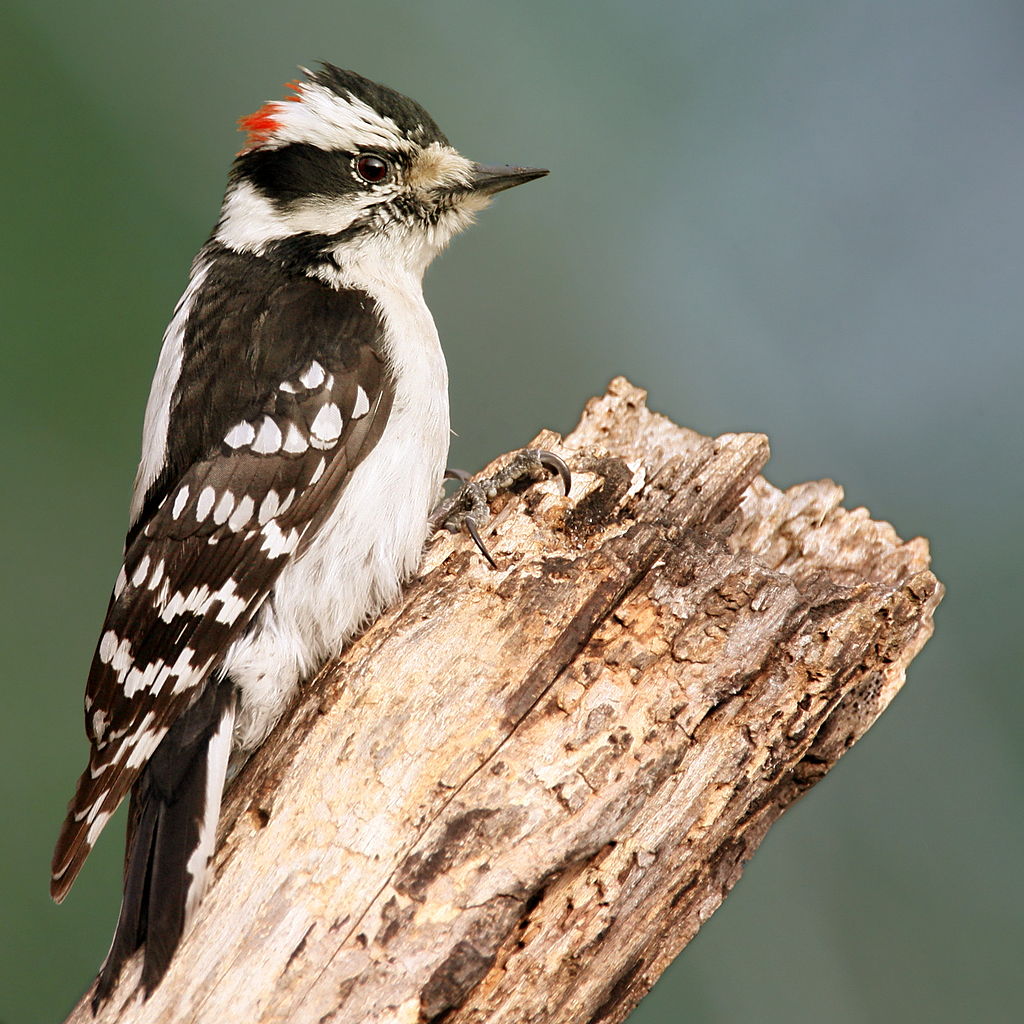
Coloration and Markings: Downy Woodpeckers have a distinctive, broad white stripe down their backs and large, black wings which bear a checkerboard pattern of white dots that starts just below the shoulders and carries down to the tips. They have short, notched tails which are black on top and white below, and the underbelly and breast of this Woodpecker are a brilliant, snowy white. Facially, these birds are white, with a black mustache line, a black mask, and a thin, black cap which terminates at a red dot at the back of the head if you are looking at a male and stays black if you are viewing a female. These birds have thin, straight, and medium-length black bills.
Size: These birds measure in at 5.5 – 6.7 inches in length and have wingspans of 9.8 to 11.8 inches wide.
Habitat: The Woodpeckers love open woods, such as meadows or copses, where the brush and the weeds are high. They do range out, visiting parks, orchards, and the occasional backyard, so be sure to leave a little something out for them. These are the tiniest Woodpeckers in North America and they are really a treat to spot.
Diet: A mix of peanut butter and suet will make a Downy Woodpecker’s day. If you notice that they are a frequent visitor, try loading up the Hummingbird feeder as well, as this sometimes tempts the Downy to take a little sip. These little guys and gals have an enormous sweet tooth.
Dark-eyed Junco – Junco hyemalis

Coloration and Markings: While there is a lot of regional variance, the most common coloration you will see is a bird with a dark gray or brown back, with medium-length wings of the same color and long tails which will be dark gray or brown on top and white on the undersides. The underbelly and breast of this bird is white, with a flanking of gray or brown starting on the sides of the underbelly and thickening in density as it approaches the breast. With the birds gray or brown head, this has the effect of the upper 2/3 of the bird being brown or gray while the lower 3rd of the body is white. When you see the bird at rest it looks a little like it’s been standing in white paint. These birds have conical, medium length pink bills.
Size: These birds measure in at 5.5 – 6.3 inches from tip to tail and have wingspans of 7.1 to 9.8 inches wide.
Habitat: Juncos love coniferous and mixed coniferous woodlands, preferring open areas and sometimes ranging into fields, roadsides, parks, and backyards.
Diet: White Proso millet, cracked corn, and broken-up Black Oil Sunflower seeds are 3 favorites of the Dark-eyed Junco which you can use to lure them in for a closer look.
House Sparrow – Passer domesticus

Coloration and Markings: Male House Sparrows have backs which are a rich brown color with a mix of black streaking. They have short, brown wings with similar streaking and short brown tails which are a dirty gray color on the undersides. The underbelly and breast of this bird are a sooty gray and the long, black bib of this bird comes down into the top of the chest. Facially, aside from the black bib, this bird has white cheeks and white at the base of the neck on the sides, with a wide eyestripe which starts as black just in front of the eyes and becomes a rich brown as it passes to curl down and around as if to frame the cheek. The forehead and the top of the bird’s head if a smooth, gray stripe and this bird has a stout, medium-length black bill with a slight downward curve to the upper bill. Female House Sparrows will be plainer in color, being more of a streaked mix of buffy brown and black on their back and with grayish-brown underbelly and breast.
Size: These birds measure in at 5.9 – 6.7 inches in length and have wingspans of 7.5 to 9.8 inches wide.
Habitat: While you might see them at farms, you won’t likely see them in the woods. House Sparrows are extremely urbanized, and would rather get handouts at the zoo or see what’s been left behind in the mall parking lot. Look for them on phone wires, fences, or already waiting in your own backyard.
Diet: White Proso millet, Black Oil Sunflower seeds, and milo are 3 of this bird’s favorite. Be sure to leave out one of more of these food types and you might just get the House Sparrow’s attentions.
Lapland Longspur – Calcarius lapponicus

Coloration and Markings: Lapland Longspurs typically have mottled brown and white backs, with medium-length wings and short tails of the same color which have white outer feathers. The underbelly and breast of this bird are white with black streaking present at the sides, just under the wings, and facially, this bird has a black mask blending into the black cheeks and bib, going all the way down into the chest. The remainder of the face is white, with the exception of a rufous mark at the back of the head and a thin, black cap. These birds have large, conical, and pointy yellow or brown bills. Females will look similar but have noticeably less black in their plumage and in the winter these birds lose most of their color, becoming mostly pale brown and streaked though you can still see some white at the outer tail feathers.
Size: These birds measure in at 5.9 – 6.3 inches in length with wingspans of 8.7 to 11.4 inches wide.
Habitat: Fields, farms, in the sands off the coast, or simply in arctic tundra, these birds are quite comfortable and suited for cold weather and locations.
Diet: These birds eat a lot of insects and seeds which they forage from the ground. While they are feeder shy, you might have a little luck sprinkling some Nyjer thistle at the base of your feeder and loading some in a ground feeder.
Purple Finch – Haemorhous purpureus
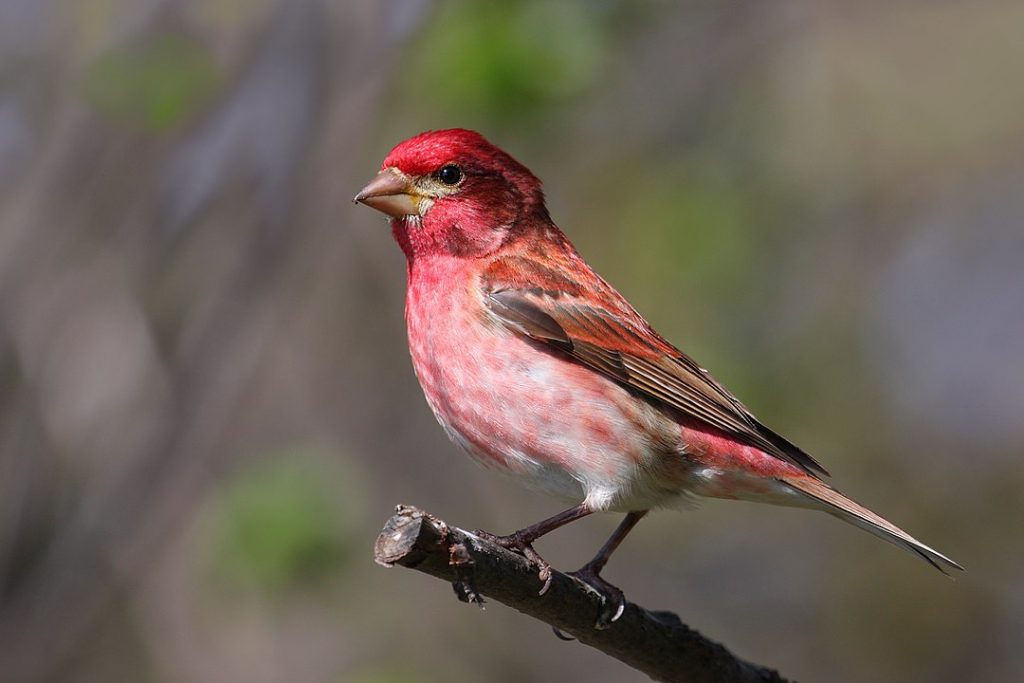
Coloration and Markings: Male Purple Finches look like small brown songbirds dipped in raspberry. They have brown backs with a pinkish-red hue to them, with small wings bearing 2 thin white wingbars each and small, notched tails. The rump, underbelly, and breast of this bird are white with red streaks flanking the underbelly which increase in density towards the breast of the bird. Facially, this bird is a raspberry red color with markings manifesting as different shades of pinkish red. Color is light on the eyebrow line, as well as at the cheeks and the throat, while the remaining majority of the face is darker raspberry color. These birds have stout, conical, medium-length bills with a touch of black present. Female Finches will lack the reddish color, being instead a light olive overall and white with heavier streaking as well as more pronounced eyebrow line and visible olive lines at the throat.
Size: These birds measure in at 4.7 – 6.3 inches in length and have wingspans of 8.7 to 10.2 inches wide.
Habitat: These Finches prefer coniferous and coniferous/deciduous mix woodlands, though in winter they begin ranging out further in order to forage and at this time you can find them at the forest’s edge, in fields, and visiting the occasion backyard to the delight of that yard’s owner.
Diet: Safflower, Black Oil Sunflower, and Niger thistle seeds are 3 favorites of the Purple Finch which can use to attempt to lure them into your backyard.
Supporting cast (Other Backyard Birds of South Dakota that might pay you a visit)
While they don’t crave the front-page attention like those fancy ‘year-round resident’ birds, our Supporting cast birds are still very much celebrities of South Dakota. Like the year-round residents, you can spot them during any season, so keep your eyes open and see if you can spot one of our Supporting cast birds at any time this year:
- American Robin
- Golden-crowned Kinglet
- Canyon Wren
- European Starling
- Eastern Bluebird
American Robin – Turdus migratorius
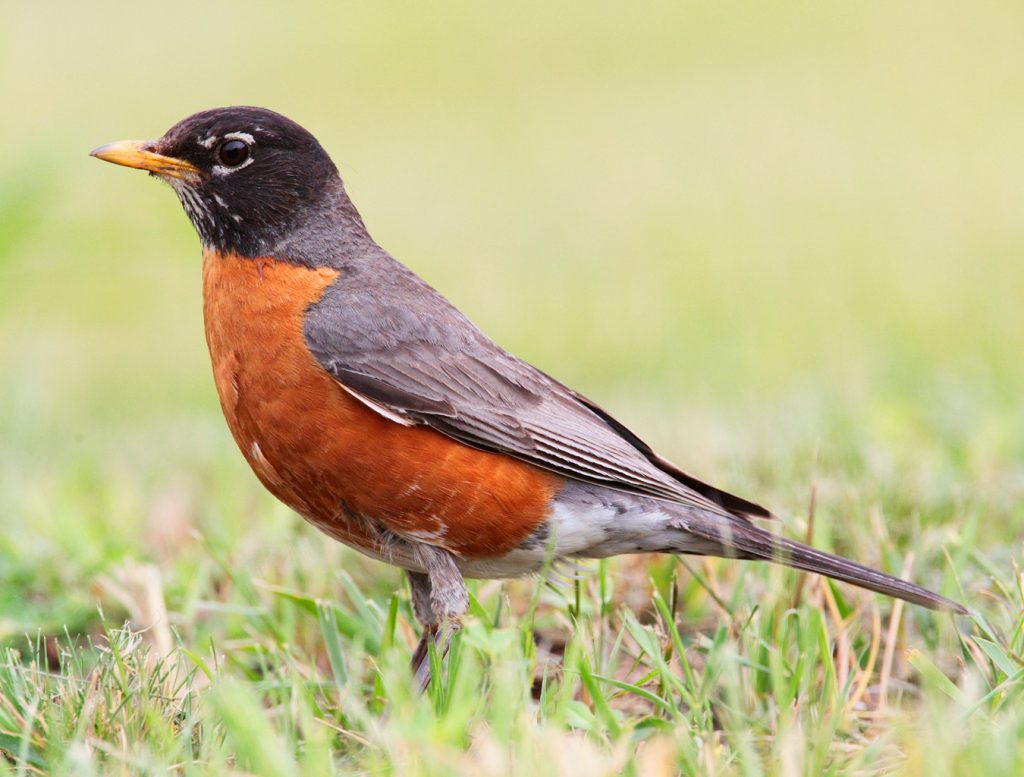
Coloration and Markings: American Robins have grayish brown backs with medium-length wings of the same color and long, grayish-brown tails which are white on the underside with the color coming from the rump. The underbelly and breast of this bird are a tangerine orange, sometimes a bit more reddish, and facially, these birds have black heads. A distinct, broken-looking white eyering surrounds both eyes and these birds have medium-length, curved yellow bills often with a small splash of black. Females will have lighter colored heads and less overall contrast to the same color palette as the male.
Size: These birds measure in at 7.9 – 11 inches in length and have wingspans of approximately 12.2 to 15.8 inches wide.
Habitat: American Robins are bold bolds and may be found in a number of different environments. Aside from the pine forests and deciduous regions of the woods, you can spot them in a snowy field, garden areas, golf courses, and especially backyards with well-stocked feeders.
Diet: Robins love crushed peanuts, suet, and Black Oil Sunflower seeds, especially if you mix in some delicious raisins. Give it a try and see for yourself!
Golden-crowned Kinglet – Regulus satrapa
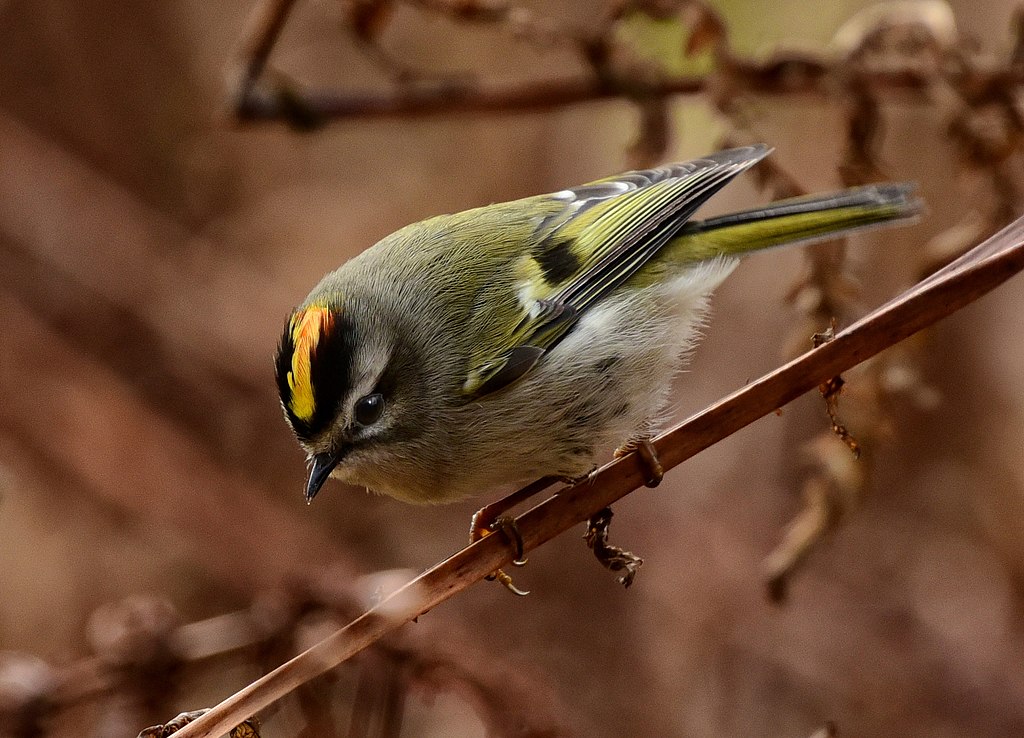
Coloration and Markings: Golden Crowned Kinglets are tiny, colorful birds. They have gray backs with small, olive colored wings which each bear a single white wingbar that has yellow on the outsides. They have thin gray and olive tails and the underbelly and breast will typically be gray or gray with a very light olive coloration present. Facially, these birds have gray faces with a thin, black mustache line present, very tiny outlines of a mask around the eyes, and their glorious yellow crowns, which are outlined with a medium-thickness of black at the base. These birds have tiny, triangular black bills.
Size: These tiny birds measure in at a mere 3.1 – 4.3 inches long and have wingspans of 5.5 – 7.1 inches wide.
Habitat: In the warmer months you can find these birds in montane or boreal woods, though they spend a lot of time in coniferous as well. During the winter, they are avid foragers, and may be found just about anywhere where the snacks are plentiful.
Diet: While primarily insectivorous, when winter comes then Kinglets have been known to start visiting suet feeders. Leave a little something out to help the little guys and gals, as it gets quite chilly out there and they would certainly appreciate your support.
Canyon Wren – Catherpes mexicanus

Coloration and Markings: Canyon Wrens are pretty little birds, with rusty-red coloration on their backs which has a blackish-gray barred pattern overlaid and the brightest color at the perky, medium-length tail, where the reddish brown is more solid and much less banded. They have small wings and the underbelly and breast are a more solid, if light reddish-brown with a flanking of gray. Facially, these birds are white at the cheeks and throat, with a white bib coming down onto the chest, and they have long and slightly curved yellow and black bills.
Size: These birds measure in at 4.5 – 6.1 inches in length and have wingspans of 7.1 to 7.9 inches wide.
Habitat: These are country birds of the slopes and the canyons, so you likely get a visit from these guys unless you live in a higher elevation.
Diet: If a rogue Wren should come to visit you’ll have the best luck with live mealworms, suet, and peanut butter.
European Starling – Sturnus vulgaris
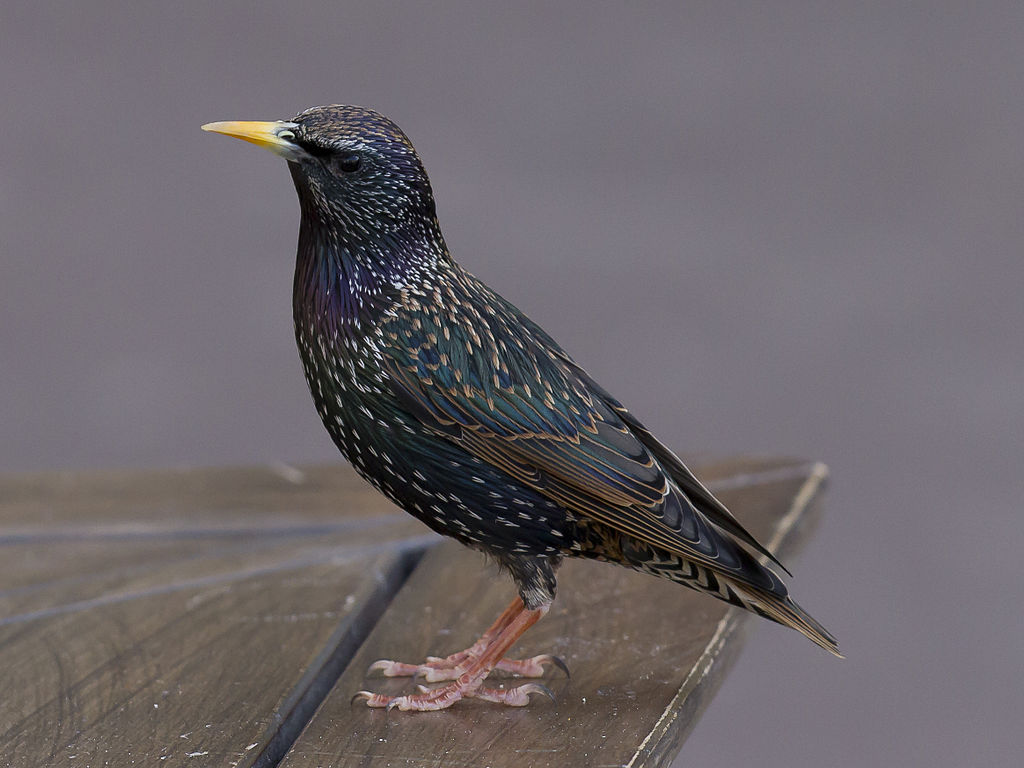
Coloration and Markings: European Starlings look like yellow-billed Blackbirds from a distance, but up close you can see that their shiny ‘black’ plumage is actually made up of brilliant purples and greens. They have long, pointy wings and relatively short tails, and when they are in flight they have distinct 4-pointed shape that looks like a 4-pointed star. The underbelly and breast of this bird are purple and green as well, as is the face, and these birds have long, stout yellow bills. During the winter, they change out of their darker plumage and put on a lovely color set of brown with beautiful white spots! Look for it this winter if you haven’t been paying attention, as these common city birds are still quite interesting and beautiful.
Size: These birds measure in at 7.5 – 9.1 inches from tip to tail and have wingspans which are 12.2 to 15.8 inches wide.
Habitat: Introduced to the U.S. in the 19th century, European Starlings have stayed close to us and prefer to spend their time in the city. Look for them on fences or phone lines and they also visit farms on occasion, where they are sometimes considered a bit of a nuisance for their tendency to find wherever humans have hidden their livestock feed.
Diet: These birds love suet but they may well eat all of it, so you can save some suet for the other birds with a Starling-proof feeder and instead leave out some wheat, rolled oats, and cracked corn. The Starlings will still be quite happy and subsequently, forced to share the suet.
Eastern Bluebird – Sialia sialis
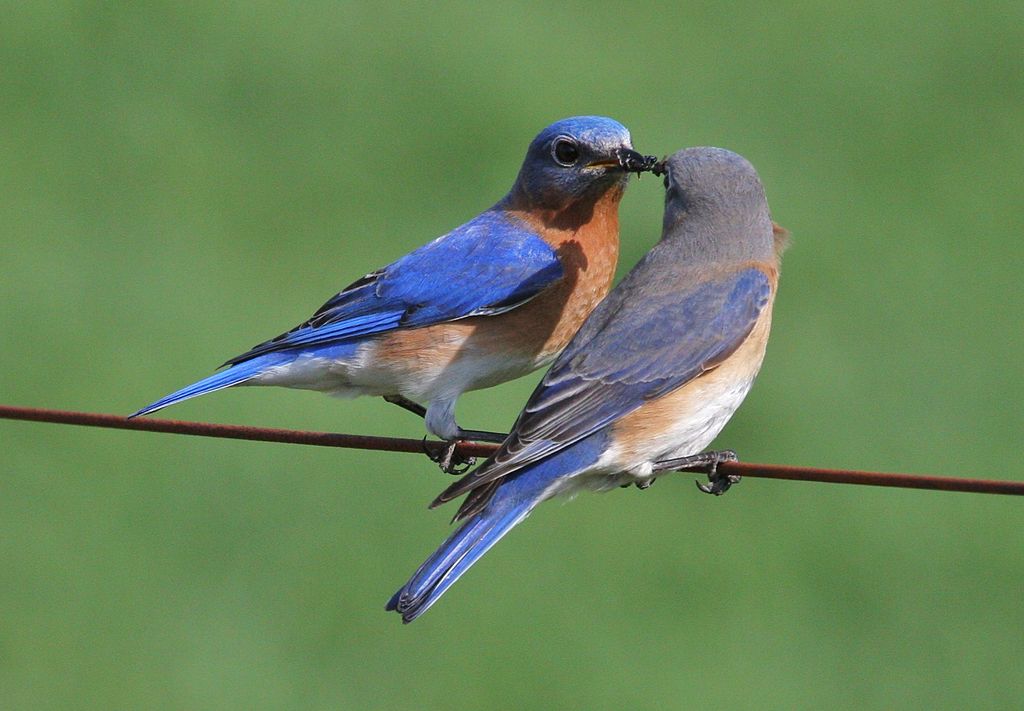
Coloration and Markings: Male Eastern Bluebirds are lovely little things. With their vibrant blue backs, small blue wings and tails, they present a lovely color contrast with a white rump and underbelly, flanked with a cinnamon-orange color that thickens and solidifies at the breast, throat, and chin. The remainder of this bird’s face if blue in color and these birds have medium length, lightly downward curved gray to black bills. Females will have some blue to their plumage, but tend to look more gray overall, and their reddish-orange coloration is a bit muted, though present.
Size: These birds measure in at 6.3 – 8.3 inches in length and have wingspans of 9.8 to 12.6 inches wide.
Habitat: These birds love open, wooded areas, especially where the trees have suitably-sized knotholes for nesting. They are attracted to nesting boxes as well so this little bird could conceivably move into your backyard if you leave out the ‘welcome mat’. You can also spot them at the edges of fields, the occasional roadside, golf courses, and of course, at your backyard feeder.
Diet: Bluebirds love fruits, suet, and will also eat crushed eggshells if you leave them out. We aren’t 100% certain why birds like the Eastern Bluebird do this but it is believed to help with digestion.
South Dakota Bird Buffet
Finding that perfect combination of delicious treats for the local birds can be a bit of an obsession for many of us birders. Today we’re enlisting the help of ‘South Dakota birds’ who have put out a helpful table for feeding the local birds and we’ll throw in a few tips of our own as well in regards to your own feeder array. If you’d like to see their table, be sure to check our reference links and there is a direct link waiting for you there. In the meantime, here are some foods that will definitely get the attention of our fine, feathered friends:
- Black Oil Sunflower
- White Proso millet
- Fruit
- Nuts
- Nectar
- Grape jelly
South Dakota Birding Hot Spots
While it’s nice when birds come to see us in our own backyards, it’s also a treat to turn the tables on these beautiful creatures by going out to visit them instead. If you’d like a chance at a choice spotting and possibly even a picture you’ll want to keep, try visiting one of these hotspots around the state. These locations are well-worth the day trip:
- Northern hotspot – Mobridge Riverfront Walking Path
- Eastern hotspot – Sioux River Red Rock Trail
- Southern hotspot – Lake Andes Rail Trail
- Western hotspot – Homestake Railroad Grade Trail
- Central hotspot – Oahe Dam Downstream Fort Pierre Trail
Detailed descriptions of each location as well as information regarding visiting and what birds you can see at these locations may be found at https://www.traillink.com/stateactivity/sd-birding-trails/
In Closing
Today we have explored the wonderful world of birding in South Dakota. You’ve got a large number of diverse avian species just waiting to be spotted, so we hope that you have made a formidable checklist. Now, just be sure to stock up those feeders and don’t forget that there are hotspots nearby. The South Dakota birds are many, beautiful, and waiting to be spotted by you!
